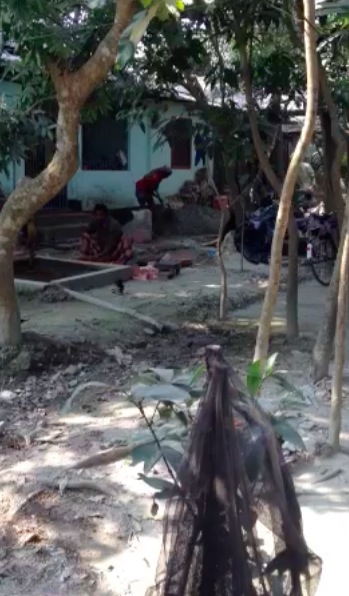Scoping the Project
Ahsan and Parvez were the advance team. In December 1998, they flew to Bangladesh to arrange a visit by the larger group, which late that month arrived to meet with government officials and NGOs. They also scouted potential sites that would simultaneously serve the research goals of medical/biological, earth science, and geochemistry teams. They collected a few samples from wells to take back to the US.
In January 1999, Columbia sent a small group of faculty to map arsenic levels in well water and evaluate people showing signs of arsenic exposure. They were gratified to learn of the British Geological Societys recently completed nationwide wells survey. The goal was to identify the most promising area for research. It was important to identify a region where wells contained low, medium and high levels of arsenic so that study participants would reflect a range of exposure (creating de facto comparison groups). Geologist Martin Stute collected water samples from Sonargaon, a community about 25 km (15.5 miles) southeast of Dhaka known to have significant levels of arsenic contamination. [11]

They expected that areas with high concentrations of arsenic would also have a population with a significant incidence of arsenicosis. The health scientists planned to take urine and blood samples from study participants, while the geosciences researchers would focus on geology and the geochemistry of arsenic in the area and on potential strategies for mitigating arsenic exposure. That meant identifying safe and unsafe sources of water and figuring out how to get people to switch to the safe sources. Water from deep aquifers was generally safer than other sources, but as the researchers would discover, the depth of low-arsenic water varied considerably (from less than 30 meters/90 feet to more than 200 meters/600 feet), even within small areas.
By May 1999, the Columbia team had a grant application ready to go to NIEHS. Graziano was listed as Principal Investigator. He knew the [NIEHS] system and that, I think, was critical to essentially attacking that problem together, says van Geen. They asked for $12 million over five years for a total of seven projects, three of them in Bangladesh. [12] The proposal included scientists from Lamont-Doherty, Mailman, and Columbias Earth Institute (itself an interdisciplinary unit examining issues from climate change to poverty and sustainability).
Alex van Geen discusses Dr. Graziano's early participation.
In November 1999, the team learned that they had been successful. [13] Nearly half the funding would go toward projects in Bangladesh: a $2.3 million long-term observational study of the effects of arsenic exposure; a separate $1.3 million study of arsenics effects on pregnant women and child development; a $650,000 study of the geology and geochemistry of groundwater arsenic; and a $540,000 study of remediation. The grant money would run from 2000-2005.
The primary Bangladesh project was called Health Effects of Arsenic Longitudinal Study, and known as HEALS. It called for a cohort of 10,000 people. [14] Researchers would collect biological samples from each participant in order to observe the long-term effects of various levels of arsenic exposure. They would also gather demographic and behavioral information. As is common with such sustained, large-scale studies, the researchers also expected to spin off additional research projects.
[11] The team collected more samples on a subsequent trip, when Yan Yheng tested 113 wells in the vicinity, including the neighboring town of Araihazar.
[12] The group proposed to study the interaction of arsenic and lead in groundwater and the possible use of ferric chloride to remove arsenic. This study would use core samples and aquifer material from sites in Bangladesh, New Jersey and Maine. Also in the US, Columbia proposed Superfund projects on the absorption by humans of lead and arsenic from contaminated soil, the genetic-level effects of arsenic on mammalian cells, and an analysis of the spread of arsenic from Superfund sites in New Jersey and Maine.
[13] For more information on the Columbia University Superfund Basic Research Program, see: http://superfund.ciesin.columbia.edu/archive/home.html .
[14] The cohort eventually increased to 12,000 so that economists Alex Pfaff and Malgosia Madajewicz from Columbias School of International and Public Affairs (SIPA) could simultaneously conduct economic and social science research projects.